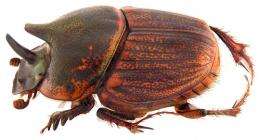November 4, 2015 report
Dung beetles found to use celestial chromatic gradient to navigate

(Phys.org)—A team of researchers with Lund University in Sweden and the University of Witwatersrand, in South Africa has found evidence that suggests that dung beetles use elements of the celestial chromatic gradient to navigate as they push balls of dung in a near straight line. In their paper published in the journal Biology Letters, the team describes an artificial environment they set up in their lab to test the navigational abilities of dung beetles and what they learned by doing so.
Dung beetles have been the object of study by many scientists because of their unique ability to roll a ball of dung in a nearly straight line for some distance without having to use physical landmarks. Prior efforts have shown the beetles use the orientation of the sun and moon, and the intensity and polarization of light to keep their bearings. In this new effort, the group has found that they also use the chromatic gradient in sunlight to keep moving in a straight line.
When sunlight hits the atmosphere, it scatters creating a wavelength-dependent gradient. One aspect of this gradient is the intensity of green light—it is much higher when facing towards the sun. UV light on the other hand is more intense when looking away from the sun. To find out if dung beetles use this contrast to help them move their dung ball, the researchers gathered several specimens and placed them in a carefully constructed environment—an indoor arena with UV and green light emitting LEDs affixed to an artificial sky.
After setting up a dung collection site in the arena, the researchers varied the types of light available to the beetles when moving their dung balls, noting which allowed them to maintain a straight line and which did not. They found that the beetles were able to keep their bearing when given either a single green or UV light or when the two types of light were placed at a 180 degree angle to each other. Turning off either light did not cause the beetle to stray off course, but if two green lights alone were lit at 180 degrees to each other, with the beetles between them, the beetles lost their way.
These results suggest that the sunlight gradient can be added to the list of environmental factors the dung beetle uses to maintain its course.
More information: Spectral information as an orientation cue in dung beetles, Biology Letters, Published 4 November 2015. DOI: 10.1098/rsbl.2015.0656
Abstract
During the day, a non-uniform distribution of long and short wavelength light generates a colour gradient across the sky. This gradient could be used as a compass cue, particularly by animals such as dung beetles that rely primarily on celestial cues for orientation. Here, we tested if dung beetles can use spectral cues for orientation by presenting them with monochromatic (green and UV) light spots in an indoor arena. Beetles kept their original bearing when presented with a single light cue, green or UV, or when presented with both light cues set 180° apart. When either the UV or the green light was turned off after the beetles had set their bearing in the presence of both cues, they were still able to maintain their original bearing to the remaining light. However, if the beetles were presented with two identical green light spots set 180° apart, their ability to maintain their original bearing was impaired. In summary, our data show that ball-rolling beetles could potentially use the celestial chromatic gradient as a reference for orientation.
Journal information: Biology Letters
© 2015 Phys.org


















